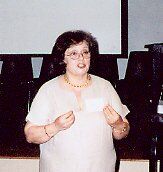
"No Child Left Behind" Sparks Innovative Strategies
Report from the NJTESOL/NJBE Summer Institute
Maryln McAdam and Moira Lenehan-Razzuri, of McA Enterprises, Inc.,
an education consulting firm in Washington, D.C., provided a
cogent overview of new and continuing regulations for assessment
of English language learners under ESEA. "The nexus between Title
I and Title III is convoluted and complex," explained Dr. McAdam.
Title I in its current form has been in effect since 1994, she
said, but there were no consequences for schools which didn't
follow the law. "Now what this [ESEA Reauthorization] act does is give teeth
to parts of the law pertaining to ELL populations."
One of the key phrases in the new law is a requirement that
to the extent practicable states assess LEP students in the
language and form most likely to yield accurate and reliable
results, according to McAdam and Lenehan-Razzuri. Their advice
is to first identify the LEP student population in the state.
"States and districts should consider what languages their LEP
students speak, their native language literacy, their language
of instruction and their level of English language proficiency,"
say McAdam and Lenehan-Razzuri in a handout now available on
the NJTESOL/NJBE Web site.
In some cases, the new law would appear to dictate that states
with significant numbers of LEP students sharing the same non-English
native language should offer assessment in content areas using
that language. Furthermore, where smaller numbers of students
speaking a particular native language are concerned, the new
ESEA statute seems to suggest that special accomodations such
as native-language interpreters be provided. In her remarks
to the NJTESOL/NJBE audience, Dr. McAdam suggested that there
may be an inherent conflict between popular "English-only"
propositions in some states and federal statutory requirements for
native-language assessment in academic content areas under the
"No Child Left Behind Act." (More info at
www.nochildleftbehind.gov and www.lep.gov)
In her workshop, "Bilingual/ESL Program Models," Dr. Garcia
(dr_garcia@georgian.edu) presented ESL and Bilingual
models which address specific provisions of the New Jersey
Administrative Code for schools.
If there are fewer than 10 LEP students enrolled within the
schools of a district, the district is required by the New
Jersey statute to offer "English language services ... in addition
to the regular school program." According to Dr. Garcia,
these services typically include: certified teachers, English
instruction designed for LEP students, and at least three
times a week. "Mainstream English language arts is not an
equivalent," explained Dr. Garcia, "and speech is not appropriate
unless a real problem has been identified."
New Jersey law requires that, when there are 10 or more
LEP students enrolled within the schools of the district,
the district shall establish an ESL program that provides
up to two periods of daily ESL instruction... This
ESL curriculum must be cross-referenced to the district's
bilingual and content area curricula, by law, to ensure
that ESL instruction is correlated to all the content areas
being taught.
Typical settings for this ESL instruction include: magnet
schools or neighborhood schools, pull-out for small-group
instruction (at the same time as art, music or computer specials),
team-teaching (two ESL teachers instruct a bilingual class
in their classroom), class periods (ESL replacing mainstream
English for grades 7-12) or vocational ESL.
Dr. Garcia reported that communication-based ESL (using
the language in meaningful, relevant ways), content-based
ESL (stressing language skills, content and vocabulary
related to content area subjects) and sheltered English
instruction (making grade-level content comprehensible
while providing language development) have been the most
effective ESL approaches.
New Jersey law also dictates the establishment of bilingual
education programs in any district with 20 or more LEP
students in any one language classification. Further,
these bilingual programs must be designed to prepare
LEP students to acquire sufficient English skills and content
knowledge to meet the Core Curriculum Content Standards
and all LEP students in bilingual programs also receive
ESL classes. Teachers must have elementary and bilingual
certification and, for secondary schools, content and bilingual
certification.
The typical model which has worked in New Jersey, according
to Dr. Garcia, is "transitional bilingual education," in which
a student receives primarily native-language instruction in
core curriculum subjects the first year, transitions to English
reading and writing during his/her second year and is taught
in English during the third year, with some native-language
support. "Transitional bilingual education is most effective
when there is a structured plan for when the actual transition
from native language to English language instruction will occur,"
said Dr. Garcia.
Another model which has been used with some success, according
to Dr. Garcia, is "Dual-Language," or two-way bilingual education.
"Dual language means a full-time program of instruction which
provides structured content area instruction in both English and
the native language," she explained. "For example, in some
districts, a dual language class might be composed of 50 percent
native speakers of another language and 50 percent native speakers
of English." Dual-language programs will vary in how they
alternate between the two language of instruction, according
to Dr. Garcia. Some will offer native language in the morning
and English in the afternoon; others, alternating daily; still
others, a week at a time in each language.
When LEP students are enrolled in dual-language programs for
six to seven years, Dr. Garcia reported, "there is evidence that
they achieve a higher degree of academic success than students
who receive transitional bilingual education or ESL-only instruction."
However, districts considering dual language must consider a
number of crucial factors, including: staff development for
mainstream, bilingual and ESL teachers and paraprofessionals;
parental awareness and support; integration with school programs;
language allocation; and integration among instructional components.
It is also important to design ways to integrate new students,
whether LEP or native English speakers, who enter the program
in subsequent years, warned Dr. Garcia. "One important topic
would be the local board of education's willingness to make the
long-term commitment which dual language programs require," she
said.
In her workshop, "Making Content Comprehensible for English
Language Learners: SIOP," Ms. O'Loughlin (Joeslteach@aol.com) described metacognitive,
cognitive and social/affective strategies we can teach
our students to help them meet the challenges of learning
in an English classroom environment.
Metacognitive strategies are grouped under three categories:
planning (advance organization, organizational planning, selective
attention and self-management), monitoring (monitoring comprehension
and monitoring production) and self-assessment.
The details of each strategy suggest ways we can help English
language learners become more effective students. The advance
organization strategy involves previewing, skimming, getting the
gist. Organizational planning means planning what to do. Selective
attention means listening or reading selectively, scanning,
finding specific information, using key words, phrases, linguistic
markers. Self-management entails planning when, where and how
to study.
Monitoring comprehension means training students to think
about certain things while listening or while reading, checking
comprehension during the process instead of at the end. Monitoring
production means checking ones oral or written production while
it is taking place. Self-assessment includes checking back, keeping
a learning log and reflecting on what you have learned.
Cognitive strategies include: resourcing (using reference materials),
grouping (classifying words, constructing graphic organizers),
note-taking (writing down key words, using idea maps, T-lists),
elaboration of prior knowledge (using what you already know, making
personal associations), summarizing (making a mental note of
information gained), deduction/induction (applying or deriving
rules to understand a concept or complete a learning task),
imagery (visualize to learn information or solve a problem),
auditory representation (mentally replaying a word or phrase)
and making inferences (using contextual clues).
Social/Affective strategies are: questioning for clarification (getting
additional explanation or verification),
cooperation (working with peers to complete a task, pool information)
and self-talk (reducing anxiety by thinking positively about
ones competence).
Judy O'Loughlin presented ways to apply these strategies for
different subject areas, including mathematics, literature,
composition, social studies and science. By training LEP students
in these strategies and giving them ample opportunities to practice
them until they are internalized, ESL teachers are giving their
students mental and social maps to become more independent learners.
Ms. O'Loughlin also led workshop participants through the
CREDE standards for effective pedagogy and learning. "These
standards represent recommendations on which the literature is
in agreement," she said, "across all cultural, racial and linguistic
groups in the United States, all age levels and all subject matters."
"Even for mainstream students," said Ms. O'Loughlin, "the standards
describe the ideal conditions for instruction. But for students
at-risk of educational failure, effective classroom implementation
of the standards is vital."
Joint Productive Activity is the first standard, which
suggests that teachers "facilitate learning through joint productive
activity among teacher and students." According to Ms. O'Loughlin,
"learning occurs most effectively when experts and novices work
together for a common product or goal, and are therefore motivated
to assist one another."
The second CREDE standard is Language Development, to "develop
competence in the language and literacy of instruction across the
curriculum." Whether in a bilingual or monolingual setting, literacy
is the crucial competency for success, explained Judy O'Loughlin.
"Language development at all levels--informal, problem-solving
and academic," she insisted, "should be fostered through use and
through purposeful, deliberate conversation between teacher and
students, not through drills and decontextualized rules."
Contextualization is the third CREDE standard, which means
to "connect teaching and curriculum to students' experiences and
skills of home and community." This standard calls for culturally
meaningful contexts, according to Ms. O'Loughlin. "Schema theorists,
cognitive scientists, behaviorists and psychological anthropologists
agree that school learning is made meaningful by connecting it
to students' personal, family and community experiences," she
explained. "Collaboration with parents and communities can reveal
appropriate patterns of participation, conversation, knowledge
and interests that will make literacy, numeracy and science
meaningful to all students."
CREDE standard number four is Challenging Activities, or
to "challenge students toward cognitive complexity." According
to Ms. O'Loughlin, students at risk, especially LEP students, are
often not seriously challenged, or are "forgiven any genuine
assessment of progress." But, "while such policies may often
be the result of benign motives," she said, "the effect is to deny
many diverse students the basic requirements of progress--high
academic standards and meaningful assessment that allows feedback
and responsive assistance."
Instructional Conversation is the fifth CREDE standard,
to "engage students through dialogue, especially the instructional
conversation." Judy O'Loughlin explained that in the instructional
conversation, "the teacher listens carefully, makes guesses
about intended meaning and adjusts responses to assist students'
efforts."
It is more than clear that the teachers and administrators of
New Jersey are far too busy trying to help the English language
learners in their schools--using every tool at their disposal--to
worry about the politics of "English only" or whether a Republican
or Democrat wrote the "No Child Left Behind Act." The NJTESOL/NJBE
workshops equipped ESL/bilingual professionals in New Jersey to
meet the new requirements of the law while giving them solid
pedagogy to use in doing so.
Reported by Robb Scott
2002 ESL MiniConference Online
 The NJTESOL/NJBE Summer Institute, held June 26-27 at Fairleigh
Dickinson University, in Hackensack, New Jersey, featured
several very useful workshops to help elementary
school and secondary school teachers and administrators
come to grips with new changes in the ESEA Reauthorization,
commonly referred to as the "No Child Left Behind Act."
For politicos who might have been looking to sharpen
their grinding axes, there wasn't much here. Instead,
participants were treated to a rational discussion of
the obligations our schools still have to educate English
language learners (ELLs) and some successful strategies
for teaching them.
The NJTESOL/NJBE Summer Institute, held June 26-27 at Fairleigh
Dickinson University, in Hackensack, New Jersey, featured
several very useful workshops to help elementary
school and secondary school teachers and administrators
come to grips with new changes in the ESEA Reauthorization,
commonly referred to as the "No Child Left Behind Act."
For politicos who might have been looking to sharpen
their grinding axes, there wasn't much here. Instead,
participants were treated to a rational discussion of
the obligations our schools still have to educate English
language learners (ELLs) and some successful strategies
for teaching them.
 Limited English Proficient (LEP) students must be included
in each state's assessment system under the new law. In addition,
the scores of LEP students have to be "disaggregated" for reporting
to parents, schools and the public and for determining yearly
progress. The Title I funding which certain schools receive
is going to be contingent on following the new LEP assessment
statutes in Title III.
Limited English Proficient (LEP) students must be included
in each state's assessment system under the new law. In addition,
the scores of LEP students have to be "disaggregated" for reporting
to parents, schools and the public and for determining yearly
progress. The Title I funding which certain schools receive
is going to be contingent on following the new LEP assessment
statutes in Title III.
 Clearly, the "No Child Left Behind Act" provides no easy answers
to schools and districts seeking to effectively educate growing
numbers of ELLs in their student populations. Neither does the
new law prevent states for whom bilingual education has been useful
from continuing to utilize this tool. In another workshop, Dr. Gloria J. Garcia,
Assistant Professor of Education and Bilingual/ESL Coordinator
at Georgian Court College, in Lakewood, New Jersey, demonstrated
with spirit and vigor that bilingual education is still alive
and well in the garden state.
Clearly, the "No Child Left Behind Act" provides no easy answers
to schools and districts seeking to effectively educate growing
numbers of ELLs in their student populations. Neither does the
new law prevent states for whom bilingual education has been useful
from continuing to utilize this tool. In another workshop, Dr. Gloria J. Garcia,
Assistant Professor of Education and Bilingual/ESL Coordinator
at Georgian Court College, in Lakewood, New Jersey, demonstrated
with spirit and vigor that bilingual education is still alive
and well in the garden state.
 At some stage in any of these approaches to teaching LEP
students, it is going to be necessary and desirable that
the learners gain the confidence and strategic skills required
for comprehending content area instruction in English. This
is the goal for all K-12 educators, whether they espouse
bilingual, dual or immersion policies. At that point in
the language and culture learning process, the "Sheltered
Instruction Observation Protocol," presented in another
workshop by Judith B. O'Loughlin, past-president of NJTESOL/NJBE
and co-coordinator of the Summer Institute,
has obvious applications.
At some stage in any of these approaches to teaching LEP
students, it is going to be necessary and desirable that
the learners gain the confidence and strategic skills required
for comprehending content area instruction in English. This
is the goal for all K-12 educators, whether they espouse
bilingual, dual or immersion policies. At that point in
the language and culture learning process, the "Sheltered
Instruction Observation Protocol," presented in another
workshop by Judith B. O'Loughlin, past-president of NJTESOL/NJBE
and co-coordinator of the Summer Institute,
has obvious applications.